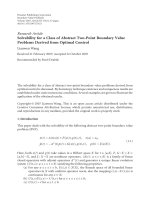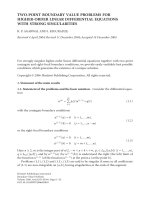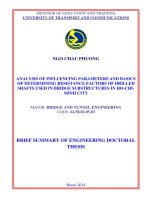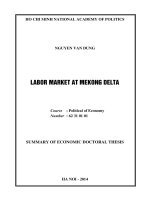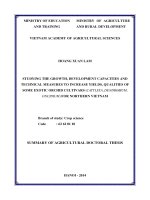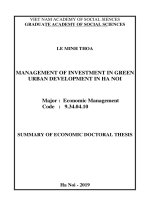- Trang chủ >>
- Sư phạm >>
- Quản lý giáo dục
Summary of Mathematics doctoral thesis: Iterative method for solving two point boundary value problems for fourth order differential equations and systems - TRƯỜNG CÁN BỘ QUẢN LÝ GIÁO DỤC THÀNH PHỐ HỒ CHÍ MINH
Bạn đang xem bản rút gọn của tài liệu. Xem và tải ngay bản đầy đủ của tài liệu tại đây (244.23 KB, 10 trang )
<span class='text_page_counter'>(1)</span><div class='page_container' data-page=1>
<b>MINISTRY OF EDUCATION </b>
<b>AND TRAINING </b>
<b>VIETNAM ACADEMY OF </b>
<b>SCIENCE AND ECHNOLOGY </b>
<b>GRADUATE UNIVERSITY OF SCIENCE AND TECHNOLOGY </b>
<b>……..….***………… </b>
NGÔ THỊ KIM QUY
<b>ITERATIVE METHOD FOR SOLVING TWO-POINT </b>
<b>BOUNDARY VALUE PROBLEMS FOR FOURTH ORDER </b>
<b>DIFFERENTIAL EQUATIONS AND SYSTEMS </b>
Major : Applied Mathematics
Code: 62 46 01 12
SUMMARY OF MATHEMATICS DOCTORAL THESIS
</div>
<span class='text_page_counter'>(2)</span><div class='page_container' data-page=2>
This thesis was completed at:
<b> Graduate University of Science and Technology </b>
<b>Vietnam Academy of Science and Technology </b>
<b>Supervisor 1: Prof. Dr. Dang Quang A </b>
<b>Supervisor 2: Assoc. Prof. Dr. Ha Tien Ngoan </b>
<b>Reviewer 1: … </b>
<b>Reviewer 2: … </b>
<b>Reviewer 3: …. </b>
The Dissertation will be officially presented in front of the Doctoral
Dissertation Grading Committee, meating at:
Graduate University of Science and Technology
<b>Vietnam Academy of Science and Technology </b>
At ...Date...Month...Year 201…
The Dissertation is avaiable at:
</div>
<span class='text_page_counter'>(3)</span><div class='page_container' data-page=3>
INTRODUCTION
1. Motivation of the thesis
Many problems in physics, mechanics and some other fields are described by
differential equations or systems of differential equations with different
bound-ary conditions. It is possible to classify the fourth-order differential equations
into two forms: fully order differential equations and non-fully
fourth-order ones. A fourth-fourth-order differential equation whose right-hand side function
contains an unknown function and its derivatives of all order (from first to
third order) is called a fully fourth-order differential equation. Otherwise, the
equation is called a non-fully fourth-order differential equation.
The boundary value problems for differential equations have attracted the
attention of scientists such as Alve, Amster, Bai, Li, Ma, Feng, Minh´os, etc.
Some Vietnamese mathematicians and mechanics, namely, Dang Quang A,
Pham Ky Anh, Nguyen Van Dao, Nguyen Dong Anh, Le Xuan Can, Nguyen
Huu Cong, Le Luong Tai, etc. also studied methods for solving the boundary
value problems for differential equations.
Among the differential equations, the nonlinear fourth-order differential
equation has been of great interest recently as it is the mathematical model
of many problems in mechanics. Here we take a look at some of the boundary
value problems for the nonlinear fourth-order differential equations.
Firstly, consider the problem of elastic beams as described by the nonlinear
fourth-order differential equation
u(4)(x) =f(x, u(x), u00(x)) (0.0.2)
or
u(4)(x) =f(x, u(x), u0(x)) (0.0.3)
where u is the deflection of the beam, 0 ≤ x ≤ L. The conditions at two ends
of beams are given in dependence of the constraints of the problems.
There have been many research results on the qualitative aspects of the
problems such as existence, uniqueness and positivity of solutions. Noteworthy
is the works of Alves et al. (2009), Amster et al. (2008), Bai (2004), Li (2010),
Ma et al. (1997), ..., where the upper and lower solution method, the variational
method, the methods of fixed point theorems are used. In these works the
conditions of the boundedness of the right-hand function or of its growth rate
at infinity is indispensable.
In the articles mentioned above, the fourth-order differential equation does
not contain third-order derivative. For the last ten years, the fully fourth-order
</div>
<span class='text_page_counter'>(4)</span><div class='page_container' data-page=4>
differential equations, namely the equation
u(4)(x) =f(x, u(x), u0(x), u00(x), u000(x)) (0.0.6)
has attracted the interest of many authors (Ehme et al. (2002), Feng et al.
(2009), Li et al. (2013), Li (2016), Minh et al. (2009), Pei et al. (2011), ...).
The main results in the these papers are the study of the existence, uniqueness
and positivity of the solution. The tools used are Leray-Schauder’s degree
theory (see Pei et al. (2011)), the Schauder fixed point theorem based on the
monotone method in the present of lower and the upper solutions (see Bai
(2007) ), Ehme et al. (2002), Feng et al. (2009), Minh´os et al. (2009)) or
Fourier analysis (see Li et al. (2013)).
However, in all of the articles mentioned above, the authors need a very
important assumption that the function f : [0,1]×<sub>R</sub>4 <sub>→</sub>
Rsatisfies the Nagumo
condition and some other conditions of monotonicity and growth at infinity. It
should be emphasized that in the monotone method the assumption of the
presence of lower and upper solutions is always needed and the finding of them
is not easy.
The system of fourth-order differential equations have not been studied
much, such as Kang et al. (2012), Lău et al. (2005), Zhu et al. (2010), in
which the authors considered the equations containing only even-order
deriva-tives associated with the simply supported boundary conditions. Under very
complicated conditions, by using a fixed point index theorem in cones, the
au-thors obtained the existence of positive solutions. But it should be emphasized
that the obtained results are of pure theoretical character because no examples
of existing solutions are shown.
Minh´os and Coxe (2017, 2018) for the first time considered the system of
coupled fully fourth-order of differential equations. The authors have provided
sufficient conditions for solving the system by using the lower and upper
solu-tions method and the Schauder fixed point theorem. Demonstrating this result
is very cumbersome and complicated and requires Nagumo conditions for the
functions f and h.
Although significant achievements have been made in investigating the
solv-ability of nonlinear boundary value problems, the development of applied fields
such as mechanics, physics, biology, etc. always yields complex new problems
for the equations as well as boundary conditions. These problems are
impor-tant in science and practice. In addition, in the articles mentioned above, the
conditions given are complex and difficult to verify. A very important
assump-tion is that the right-hand side funcassump-tion satisfies the Nagumo condiassump-tion and
some other conditions of monotonous and growth properties at infinity. For the
monotone method, the assumption of the presence of lower and upper solutions
is always needed and the finding of them is not easy. Moreover, some articles
do not have illustrative examples for theoretical results. Thus, continuing the
qualitative and quantitative study of new problems for the fourth-order
differ-ential equations and systems with different boundary conditions is crucial in
research and practice.
For these reasons, we decide a subject for this dissertation with the title
</div>
<span class='text_page_counter'>(5)</span><div class='page_container' data-page=5>
2. Objectives and scope of the thesis
The objective of the thesis is to develop the iterative method and combining
it with other methods to study qualitative and especially the method of solving
some two-point boundary problems for the fourth-order differential equations
and systems, arising in beam bending theory without using condition of growth
rate at infinity, Nagumo condition, etc. of the right-hand side function.
3.
Research methodology and content of the
thesis
Using the approach of reducing the original nonlinear boundary value
prob-lems to operator equations for right-hand side functions, along with the tools
of analytical mathematics, functional analysis, differential equation theory, we
study the existence, uniqueness and some properties for the solutions of some
problems for fully or non-fully nonlinear fourth-order differential equations and
systems.
Also on the basis of the operator equation, we construct an iterative method
for finding the solutions of the problems of problems and prove the convergence
of the method. Some examples are given, where exact solutions are known or
unknown, to demonstrate the applicability of the obtained theoretical results
and the efficiency of the iterative method.
4. The major contribution of the thesis
The thesis proposes a method for researching qualitative aspects and an
iterative method for solving boundary value problems for fully or non-fully
nonlinear fourth-order differential equations and systems by using the
reduc-tion of them to the operator equareduc-tions for the right-hand side funcreduc-tions. The
results are:
• Establish the existence, uniqueness and some properties for the solutions of
problems under some easily verified conditions.
• Propose an iterative methods for solving these problems and prove the
con-vergence of the iterative process.
• Give some examples illustrating the applicability of the obtained theoretical
results including examples where the existence or uniqueness is not guaranteed
by other authors because these examples do not satisfy the conditions in their
theorems.
• Computational experiments illustrate the effectiveness of iterative methods.
The thesis is written on the basis of articles [1]-[6] in the list of works of the
author related to the thesis.
5. The structure of the thesis
Besides the introduction, conclusion and references, the contents of the thesis
are presented in three chapters.
</div>
<span class='text_page_counter'>(6)</span><div class='page_container' data-page=6>
Chapter 1 presents some preparatory knowledge including some fixed point
theorems; the monotone method for solving boundary value problem of
differ-ential equations; Green function for some problems and numerical methods for
solving differential equations. The basic knowledge presented in Chapter 1 will
play a very important role, as the basis for the results which will be presented
in Chapter 2 and Chapter 3.
In Chapter 2, by using the reduction of the nonlinear boundary value
prob-lems to the operator equation of the right-hand side function rather than of the
unknown function, we have established the existence, uniqueness and properties
of solutions for fully or non-fully fourth-order nonlinear differential equations.
Also on the basis of the operator equation, we construct the iteration
meth-ods for solving the problems and prove the convergence of the methmeth-ods. Some
examples are given, where exact solutions are known or are not known,
demon-strating the applicability of the obtained theoretical results and the efficiency
of the iterative method.
Continuing the developent of the techniques in Chapter 2, in Chapter 3,
for the system of coupled fully or non-fully nonlinear fourth-order differential
equations, we also obtain the results of existence, uniqueness and convergence
of the iterative method. These results further enrich and confirm the
effective-ness of the approach of reducing nonlinear boundary problems to the operator
equations for right-hand side functions.
</div>
<span class='text_page_counter'>(7)</span><div class='page_container' data-page=7>
Chapter 1
Preliminary knowledge
This chapter presents some preparation knowledge needed for subsequent
chapters referenced from the literatures Ladde (1985), Melnikov et al. (2012),
Samarskii et al. (1989), Zeidler (1986).
1.1
Some fixed point theorems
In this section, we present three fixed point theorems applied in the study of
the existence, the unique solution of differential equations: Banach fixed point
theorem, Brouwer fixed point theorem and Schauder fixed point theorem.
1.2
Monotone method for solving boundary value
problem for differential equations
One of the more common methods of qualitative research (existence,
unique-ness) of the solution and the approximate solution of the differential equation is
the monotone method. The method has attracted the attention of researchers
in recent years. This method is popular because it not only provides a way to
prove the theorems that exist, but also leads to different results, which is an
effective technique for studying the qualitative properties of the solution.
Suppose there exists an ordered pair of lower and upper solution α and β,
that is, α and β are smooth functions with α ≤ β. Based on the property of
lower and upper solution, one establishes that the sequenceαk is monotone
non-decreasing and the sequence βk is monotone nonincresing, and both sequences
converge to a solution (say u and u) of the problem. The monotone property
of these sequences leads to the relation
α ≤ α1 ≤ α2 ≤... ≤αk ≤ ...≤ u ≤ u≤ ... ≤βk ≤ ... ≤β2 ≤ β1 ≤ β.
When u = u, there is a unique solution in the sector hα, βi, otherwise the
problem has lower extreme and upper extreme solutions.
1.3
Green function for some problems
Green function has broad application in the study of boundary value
prob-lems. In particular, the Green function is an important tool for indicating the
</div>
<span class='text_page_counter'>(8)</span><div class='page_container' data-page=8>
existence and uniqueness of solutions to problems.
Consider the problem of linear boundary value
L[y(x)] ≡ p0(x)
dny
dxn +p1(x)
dn−1y
dxn−1 + ...+pn(x)y = 0, (1.3.1)
Mi(y(a), y(b)) ≡
n−1
X
k=0
αi<sub>k</sub>d
k<sub>y(a)</sub>
dxk +β
i
k
dky(b)
dxk
= 0, i = 1, ...n, (1.3.2)
where pi(x), i = 0, ...n are continuous functions on (a, b), the leading coefficient
p0(x) must be non-zero in all points in (a, b).
Definition 1.4. (Melnikov et al. (2012)) The function G(x, t) is said to be the
Greens function for the boundaryvalue problem (1.3.1)-(1.3.2), if, as a function
of its first variable x, it meets the following defining criteria, for any t ∈ (a, b) :
(i) On both intervals [a, t) and (t, b], G(x, t) is a continuous function having
continuous derivatives up to nth order, and satisfies the governing equation in
(1.3.1) on (a, t) and (t, b), i.e.:
L[G(x, t)] = 0, x ∈ (a, t); L[G(x, t)] = 0, x ∈ (t, b).
(ii) G(x, t) satisfies the boundary conditions in (1.3.2), i.e.:
Mi(G(a, t), G(b, t)) = 0, i = 1, ..., n.
(iii) For x = t, G(x, t) and all its derivatives up to (n−2) are continuous x
lim
x→t+
∂kG(x, t)
∂xk −<sub>x</sub>lim<sub>→</sub><sub>t</sub>−
∂kG(x, t)
∂xk = 0, k = 0, ..., n−2.
(iv) The (n−1)th derivative of G(x, t) is discontinuous when x = t, providing
lim
x→t+
∂n−1G(x, t)
∂xn−1 −<sub>x</sub>lim<sub>→</sub><sub>t</sub>−
∂n−1G(x, t)
∂xn−1 = −
1
p0(t)
.
The following theorem specifies the conditions for existence and uniqueness of
the Greens function.
Theorem 1.6. (Melnikov et al. (2012)) (Existence and uniqueness). If the
ho-mogeneous boundary-value problem in (1.3.1)-(1.3.2) has only a trivial solution,
then there exists an unique Greens function associated with the problem.
Consider the linear inhomogeneous equation
L[y(x)] ≡p0(x)
dny
dxn +p1(x)
dn−1y
dxn−1 +...+ pn(x)y = −f(x), (1.3.3)
subject to the homogeneous boundary conditions
Mi(y(a), y(b)) ≡
n−1
X
k=0
αi<sub>k</sub>d
k<sub>y(a)</sub>
dxk +β
i
k
dky(b)
dxk
</div>
<span class='text_page_counter'>(9)</span><div class='page_container' data-page=9>
where the coefficients pj(x) and the right-hand side term f(x) in the governing
equation are continuous functions, with p0(x) 6= 0 trn (a, b), and Mi represent
linearly independent forms with constant coefficients.
The following theorem establishes the relation between the uniqueness of
solutions of (1.3.3)-(1.3.4) in terms of the Greens function, constructed for the
corresponding homogeneous boundary value problem.
Theorem 1.7. (Melnikov et al. (2012)) If the homogeneous boundary-value
problem corresponding to (1.3.3)-(1.3.4)has only the trivial solution, thennthe
unique solution for (1.3.3)-(1.3.4) has a unique solution can be expressed by the
integral
y(x) =
Z b
a
G(x, t)f(t)dt,
whose kernel G(x, t) is the Greens function of the corresponding homogeneous
problem.
1.4
Numerical method for solving differential
equations
To solve the boundary value problems for differntial equations, one can find
their exact solutions in a very small number of special cases. In general, one
needs to seek their approximations by approximation methods. For nonlinear
equations, the use of approximation methods is almost inevitable. In solving
differential equations for differential equations, one can find their exact solutions
in a very small number of special cases. In general, one needs to seek their
approximations by approximation methods. For nonlinear equations, the use
of approximation methods is almost inevitable. Difference method is one of the
numerical methods for approximating differential equations. The general idea
of difference method is to reduce a differential problem to a discrete problem
on a grid of points leading to solving a linear algebraic system of equations.
The boundary value problem for the second-order differential equations, by
the three-point difference method, leads soving of the system of equations with
tridiagonal matrix. One of the effective direct methods of solving this problem
is the progonka method (a special type of elemination method). In Section 1.4
we present in detail the method to solve tridiagonal systems(see Samarskii et
al. (1989)).
</div>
<span class='text_page_counter'>(10)</span><div class='page_container' data-page=10>
Chapter 2
Iterative method for solving boundary
value problems for the nonlinear
fourth-order differential equations
Boundary value problems for the nonlinear fourth order equations with
dif-ferent boundary conditions have been studied in a number of articles in recent
years. Existence of solutions these problems is established using the
Leray-Schauder theory (Pei et al. (2011)), Leray-Schauder fixed point based on the
mono-tone method in the present of lower and upper solutions, for example, Bai
(2007), Ehme et al. (2002), Feng et al. (2009), Minh´os et al. (2009) or Fourier
analysis (Li et al. (2013)). In these works the conditions of the boundedness
of the right-hand side function or of its growth rate at infinity is indispensable.
In the articles above, the authors give the original problem of the operator
equation for the unknown function u(x). Differently from that approach, in the
articles [1]-[4], we reduce the initial problem of the operator equation for the
right-hand side function ϕ(x) = f(x, u(x), v(x), ...). This idea originates from
an earlier paper by Dang Quang A (2006) when studying the Neumann problem
for harmonic equations. The result is that we have established the existence and
uniqueness of solution and the convergence of an iterative method for solving
the original problem without the above assumptions. Instead of the condition
for the right-hand side function in the whole space of variables we only need to
consider this function in a bounded domain. This effective approach consists
in the reduction of the problem to an operator equation for the right-hand side
function instead of the functionu(x) to be sought as the other authors did. The
numerical realization of the problems is reduced to the solution of two linear
sec-ond order boundary value problems at each iteration. This allows to construct
numerical methods of higher order accuracy for the problem. We illustrate the
obtained theoretical results on some example, where the exact solution of the
problem is known or unknown.
</div>
<!--links-->


